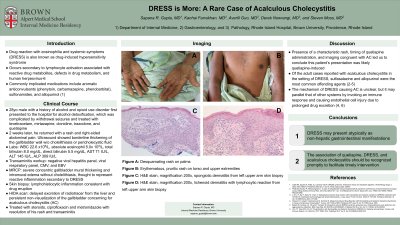Tuesday Poster Session
Category: Biliary/Pancreas
P3605 - DRESS is More: A Rare Case of Acalculous Cholecystitis
Tuesday, October 29, 2024
10:30 AM - 4:00 PM ET
Location: Exhibit Hall E

Has Audio

Sapana R. Gupta, MD
Brown University / Rhode Island Hospital
Providence, RI
Presenting Author(s)
Sapana R. Gupta, MD1, Kanhai Farrakhan, MD2, Averill Guo, MD2, Derek Nowrangi, MD2, Steven Moss, MD2
1Brown University / Rhode Island Hospital, Providence, RI; 2Rhode Island Hospital, Providence, RI
Introduction: Drug reaction with eosinophilia and systemic symptoms (DRESS) is thought to occur secondary to lymphocyte activation associated with reactive drug metabolites, defects in drug metabolism, and eosinophilia. Commonly implicated medications include aromatic anticonvulsants (phenytoin, carbamazepine, phenobarbital), sulfonamides, and allopurinol. This is a rare case of acalculous cholecystitis due to quetiapine-induced DRESS.
Case Description/Methods: A 28-year-old male with a history of alcohol and opioid use disorder presented with fever, right-sided abdominal pain, and an erythematous rash on his right arm which spread across his body (Figure 1A-B). One month prior he was treated for alcohol withdrawal seizures with levetiracetam, mirtazapine, clonidine, trazodone, and quetiapine. Laboratory data demonstrated manual eosinophil 30%, absolute eosinophil 5.5 x 109/L, total bilirubin 6.4 mg/dL, direct bilirubin 4.1 mg/dL, AST 52 IU/L, ALT 121 IU/L, ALP 167 IU/L, and WBC 18.2 x109/L. He was started on empiric antibiotics with ciprofloxacin and metronidazole. Prednisone was initiated for presumed DRESS and ultimately skin biopsy demonstrated lymphohistiocytic inflammation consistent with drug eruption (Figure 1C-D). The causative agent was likely quetiapine given the timing of drug administration. The rash and eosinophilia improved after steroid treatment and, after 48 hours, antibiotics were discontinued. Three days after discontinuation of antibiotics, the patient experienced worsening abdominal pain and rising liver enzymes. MRCP revealed severe concentric gallbladder mural thickening and intramural edema without cholelithiasis. A HIDA scan demonstrated delayed excretion of radiotracer from the liver and persistent non-visualization of the gallbladder, consistent with acalculous cholecystitis. The patient was restarted on ciprofloxacin and metronidazole and subsequently had complete resolution of his symptoms.
Discussion: Cases of adults with acalculous cholecystitis in the setting of DRESS have been described in the literature in five instances. None of these five cases identified quetiapine as the causative agent. Every patient responded to antibiotics and/or steroids. While rare, the association between DRESS and acalculous cholecystitis should promptly be recognized to facilitate timely intervention.

Disclosures:
Sapana R. Gupta, MD1, Kanhai Farrakhan, MD2, Averill Guo, MD2, Derek Nowrangi, MD2, Steven Moss, MD2. P3605 - DRESS is More: A Rare Case of Acalculous Cholecystitis, ACG 2024 Annual Scientific Meeting Abstracts. Philadelphia, PA: American College of Gastroenterology.
1Brown University / Rhode Island Hospital, Providence, RI; 2Rhode Island Hospital, Providence, RI
Introduction: Drug reaction with eosinophilia and systemic symptoms (DRESS) is thought to occur secondary to lymphocyte activation associated with reactive drug metabolites, defects in drug metabolism, and eosinophilia. Commonly implicated medications include aromatic anticonvulsants (phenytoin, carbamazepine, phenobarbital), sulfonamides, and allopurinol. This is a rare case of acalculous cholecystitis due to quetiapine-induced DRESS.
Case Description/Methods: A 28-year-old male with a history of alcohol and opioid use disorder presented with fever, right-sided abdominal pain, and an erythematous rash on his right arm which spread across his body (Figure 1A-B). One month prior he was treated for alcohol withdrawal seizures with levetiracetam, mirtazapine, clonidine, trazodone, and quetiapine. Laboratory data demonstrated manual eosinophil 30%, absolute eosinophil 5.5 x 109/L, total bilirubin 6.4 mg/dL, direct bilirubin 4.1 mg/dL, AST 52 IU/L, ALT 121 IU/L, ALP 167 IU/L, and WBC 18.2 x109/L. He was started on empiric antibiotics with ciprofloxacin and metronidazole. Prednisone was initiated for presumed DRESS and ultimately skin biopsy demonstrated lymphohistiocytic inflammation consistent with drug eruption (Figure 1C-D). The causative agent was likely quetiapine given the timing of drug administration. The rash and eosinophilia improved after steroid treatment and, after 48 hours, antibiotics were discontinued. Three days after discontinuation of antibiotics, the patient experienced worsening abdominal pain and rising liver enzymes. MRCP revealed severe concentric gallbladder mural thickening and intramural edema without cholelithiasis. A HIDA scan demonstrated delayed excretion of radiotracer from the liver and persistent non-visualization of the gallbladder, consistent with acalculous cholecystitis. The patient was restarted on ciprofloxacin and metronidazole and subsequently had complete resolution of his symptoms.
Discussion: Cases of adults with acalculous cholecystitis in the setting of DRESS have been described in the literature in five instances. None of these five cases identified quetiapine as the causative agent. Every patient responded to antibiotics and/or steroids. While rare, the association between DRESS and acalculous cholecystitis should promptly be recognized to facilitate timely intervention.

Figure: Figure 1: A) Desquamating rash on palms, B) Erythematous, pruritic rash on upper extremities, C) H&E stain, magnification 200x, Spongiotic dermatitis from left upper arm skin biopsy, D) H&E stain, magnification 200x, lichenoid dermatitis with lymphohistiocytic reaction from left upper arm skin biopsy
Disclosures:
Sapana Gupta indicated no relevant financial relationships.
Kanhai Farrakhan indicated no relevant financial relationships.
Averill Guo indicated no relevant financial relationships.
Derek Nowrangi indicated no relevant financial relationships.
Steven Moss indicated no relevant financial relationships.
Sapana R. Gupta, MD1, Kanhai Farrakhan, MD2, Averill Guo, MD2, Derek Nowrangi, MD2, Steven Moss, MD2. P3605 - DRESS is More: A Rare Case of Acalculous Cholecystitis, ACG 2024 Annual Scientific Meeting Abstracts. Philadelphia, PA: American College of Gastroenterology.
